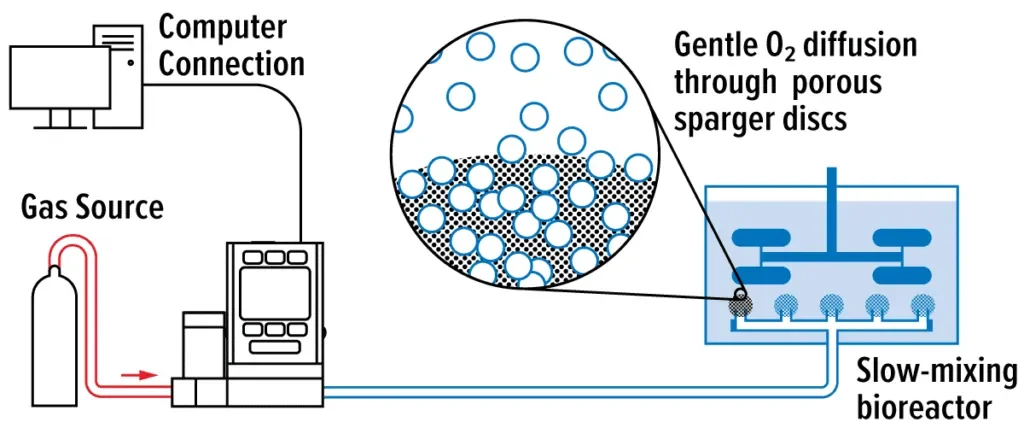Addressing scaling challenges of bioreactor sparging using mass flow control
This article was originally published in Fluid Handling Pro on June 29, 2021. Read the original article here.

Bioreactor sparging systems are designed to introduce oxygen to feed cell cultures while removing carbon dioxide to prevent toxic buildup. Various bioreactor features and components are critical to optimizing these processes. Spargers, impellers, baffling, and bioreactor shape all affect mass transfer.
Here we focus on the use of spargers in bioreactors and discuss the technological challenges of micro and macro spargers, as well as pulse-modulated sparging as a solution.
Background: Regulating oxygen and carbon dioxide levels in bioreactors
Smaller bioreactors can effectively distribute oxygen and strip carbon dioxide without spargers. However, these measures are inadequate for larger bioreactors, where the lower surface-area-to-volume ratio leads to carbon dioxide accumulation and prevents oxygen penetration. Spargers are therefore necessary to introduce oxygen and remove carbon dioxide.
Oftentimes, systems with both micro and macro spargers are useful because they are equipped to serve diverse process needs. For example, the larger bubbles produced by macro spargers can effectively remove dissolved CO2 from the solution, however, the large bubbles require strong agitation to break them up and release oxygen.
While this may be fine for hardy cell lines, the agitation can result in damage to more fragile mammalian cells. In these cases, a lower-powered macro sparger can first be used to remove CO2 and then a tandem micro sparger can be used to produce smaller bubbles that deliver oxygen more efficiently.
Challenge: Bubble features determine O2 mass transfer & CO2 stripping rates
Bubble formation and size significantly affect how oxygen will disperse throughout the bioreactor. The features of the bubbles are significantly influenced by factors such as pore size and distribution, sparger material, flow rate, liquid and gas properties, and pressures. For example, micro spargers tend to create smaller, spherical bubbles and macro spargers tend to create bubbles that are a bit larger and unevenly shaped.
The bubbles produced by micro spargers are micron-sized and spherical, and surface tension is the dominating force as they move through the bioreactor. They, therefore, have a high residency time in the reactor, which improves oxygen mass transfer but makes them ill-suited for stripping carbon dioxide from the culture.
Macro spargers produce bubbles with diameters averaging 1-4 mm, with surface tension and buoyancy in the broth combining to affect their shape and movement. These bubbles have shorter residence times but dissolve less easily than smaller bubbles. However, macro spargers may also produce larger, asymmetric bubbles, and inertial forces dominate their behavior. These bubbles are prone to collapse without either dissolving or stripping carbon dioxide.
The shape and size of the bubble determine the amount of shear stress that the cells will experience, the effectiveness of CO2 stripping from the system, and the overall oxygen mass transfer rate to the cells. It is therefore important to optimize bioreactor spargers to ensure oxygen bubbles are evenly sized and distributed, and will not damage the cells.
Solution: Pulse-modulated sparging using mass flow controllers
Pulse-modulated sparging is a method of sparging by which engineers can best regulate bubble size and speed of release into the bioreactor. A low-flow mass flow controller slowly introduces oxygen into a porous sparger disc. The disc does not immediately release the gas. Instead, pressure builds up until it reaches a critical point when the bubbles are gently released into the bioreactor.
Using this method of sparging, the oxygen mass flow rate can be adjusted to control the release rate of the bubbles into the bioreactor. The holes in the sparger disc are small enough that bubbles will form predictably. This bioreactor sparging technology is therefore scalable across vessel sizes, with an oxygen transfer rate that is proportional to the gas flow rate.